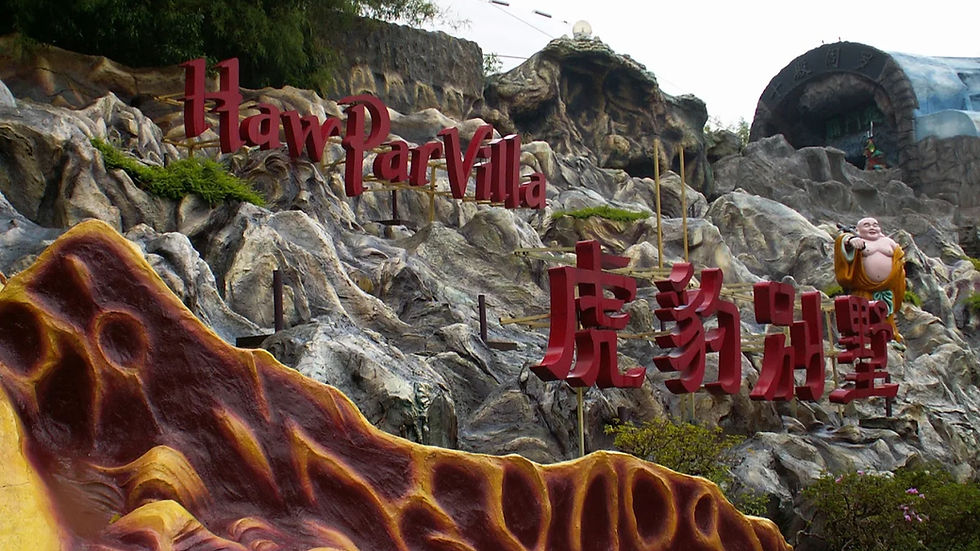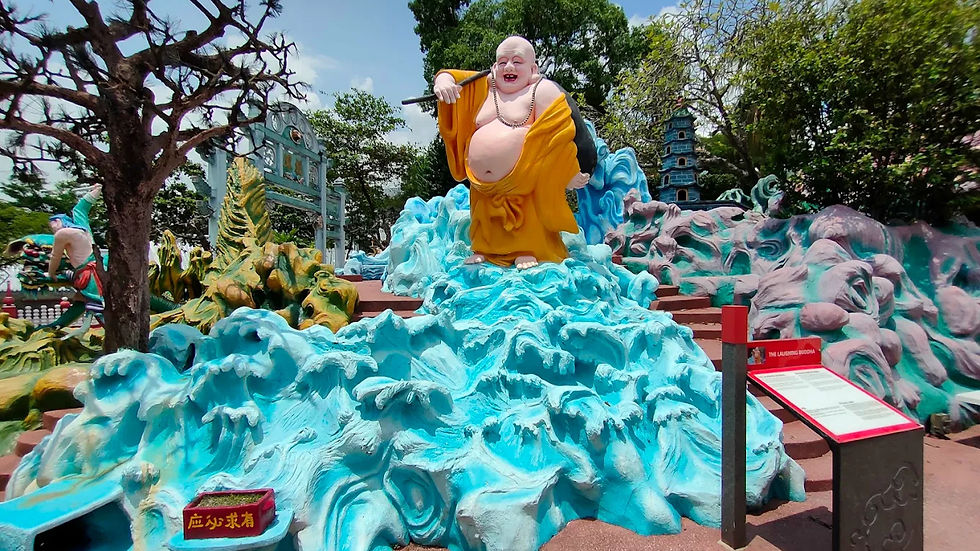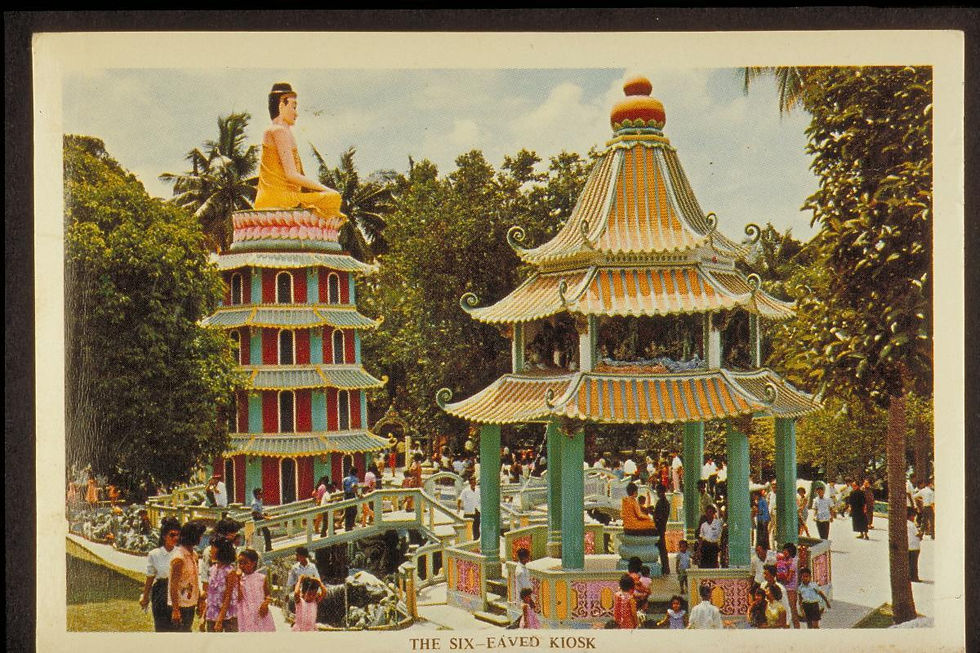Is Haw Par Villa Singapore's Strangest Attraction?
- lionheartlanders

- Aug 19, 2025
- 4 min read
When most people think of Singapore's must-see attractions, they picture gleaming skyscrapers, futuristic gardens, or bustling shopping districts. But hidden along Pasir Panjang Road lies something far more profound and mysterious Haw Par Villa, a place where ancient Chinese wisdom meets surreal artistry in ways that will challenge everything you think you know about this modern city-state. For those seeking authentic heritage experiences that go beyond the typical tourist trail, Lion Heartlanders' National Education guided walks offer deep, meaningful explorations that help unlock the true stories and cultural significance of Singapore's most misunderstood treasures.
The Story Behind the Statues

The eccentric wonderland that is Haw Par Villa wasn't born from mere wealth it was born from homesickness, brotherhood, and an unwavering belief in the power of education. In 1937, Burmese-Chinese entrepreneur Aw Boon Haw commissioned this extraordinary hillside villa for his younger brother Aw Boon Par, both of whom had built their fortune on their father's herbal remedy that would become the world-famous Tiger Balm ointment.
But Aw Boon Haw had grander ambitions than simply creating a luxurious retreat. The elder brother, whose name means "gentle tiger," was a passionate advocate for Chinese culture and education. He envisioned the gardens as a form of "edu-tainment" decades before the term was even coined a place where Singapore's largely illiterate Chinese immigrant population could learn traditional values through vivid visual storytelling.
The park's name itself tells the story of these remarkable siblings: "Haw" and "Par" meaning "tiger" and "leopard" respectively, reflecting their chosen names that honored both their family's medicinal legacy and their own fierce entrepreneurial spirits.
What Those Strange Statues Really Mean

Heroes on an Epic Quest
Among the most elaborate dioramas are scenes from the classical Chinese novel "Journey to the West," featuring the beloved Monkey King Sun Wukong, the devoted monk Xuanzang, and his companions including the loyal Pigsy. These aren't just random mythological characters they represent the eternal human journey toward enlightenment, wisdom, and spiritual growth. The white horse carrying Xuanzang is actually a dragon king's son in disguise, symbolizing how divine assistance often comes in humble forms.
Shocking Displays of Devotion
Perhaps the most startling statue for first-time visitors depicts a woman breastfeeding an elderly woman a scene that exemplifies filial piety, one of Confucianism's most sacred values. This powerful tableau tells the story of a daughter-in-law who nourished her aging mother-in-law with her own breast milk when the elder woman became too frail to consume solid food. While shocking to modern sensibilities, this display represents the ultimate expression of respect and care for one's elders, a cornerstone of traditional Chinese society.
The Eight Immortals and Lessons in Character
The colorful statues of the Eight Immortals each embody different virtues and life paths, from the scholarly to the humble, representing how enlightenment can be achieved regardless of one's social status or background. These figures serve as moral compasses, showing visitors that wisdom and virtue come in many forms.
Singapore's Most Intense Moral Lesson

No discussion of Haw Par Villa is complete without addressing its most infamous attraction the Ten Courts of Hell. Far from being mere shock value, these graphic dioramas represent a sophisticated theological and philosophical system that has guided Chinese moral thinking for centuries.
Based on Buddhist and Taoist teachings, the exhibit depicts the journey of souls through judgment and punishment before reincarnation. Each court represents different types of earthly sins and their corresponding afterlife consequences: tax dodgers face relentless pounding, those who waste food are sawed in half, and examination cheaters have their organs removed. While undeniably graphic, these scenes served as powerful moral deterrents in an era when visual storytelling was the primary means of mass education.
The recently renovated Hell's Museum Complex now provides deeper context for these displays, exploring how different cultures worldwide have conceived of death, judgment, and the afterlife. This $18 adult admission area (children $10, not recommended for under 9) transforms what was once simply shocking into genuinely educational.
A Park That's Survived the Decades

Haw Par Villa has weathered remarkable changes since its 1930s heyday. During World War II, the original seven-domed villa was destroyed by Japanese bombing, though the gardens survived. In the 1980s, when it ranked among Singapore's top three tourist attractions, the park underwent massive expansion as "Dragon World," complete with boat rides through the Ten Courts of Hell and elaborate water features.
Unfortunately, the commercialization backfired. High entrance fees (reaching $15) drove away local families, and when the park returned to free admission in 1998, much of the interactive entertainment had been removed. The famous boat ride that once carried visitors through a dragon's mouth into hell became a memory, along with puppet shows and live performances that once filled the grounds with energy.
Today's Haw Par Villa represents a renaissance of sorts. Under the management of heritage specialists Journeys Pte Ltd since 2015, the park has undergone careful restoration while maintaining its authentic character. Visitor numbers have steadily increased, reaching 350,000 in 2019 before the pandemic, proving that Singapore's appetite for meaningful heritage experiences remains strong.
Planning Your Journey Into Wonder
The power of places like Haw Par Villa lies not just in their visual impact, but in their ability to connect us with the deeper currents of human wisdom and cultural continuity. When experienced with proper context and understanding something that Lion Heartlanders' National Education guided walks excel at providing these seemingly strange statues transform into profound teachers, offering insights into values of respect, morality, and spiritual growth that remain as relevant today as they were nearly a century ago.
In an age of digital entertainment and virtual experiences, Haw Par Villa stands as a testament to the enduring power of storytelling through art. It challenges us to look beyond the surface, to find meaning in the mysterious, and to appreciate the complex cultural heritage that makes Singapore far more than just a modern city-state. For those willing to venture beyond the conventional tourist path, this extraordinary park offers nothing less than a journey into the heart of Asian philosophical tradition—one bizarre, beautiful statue at a time.




Comments